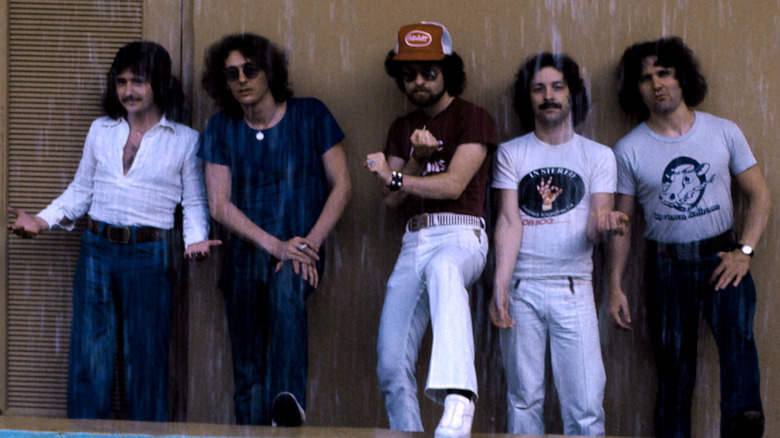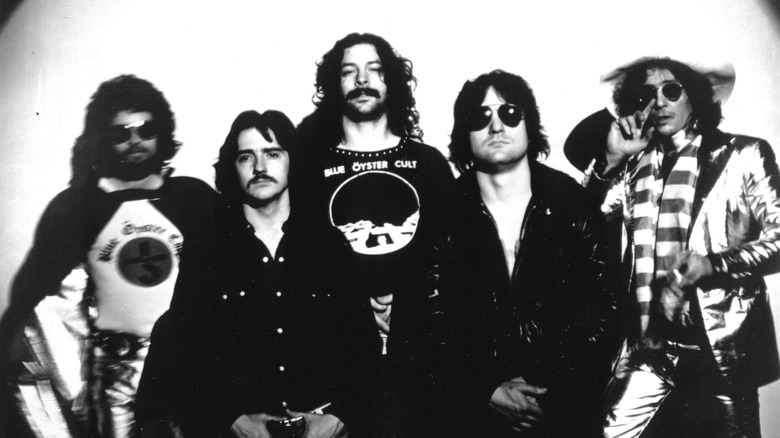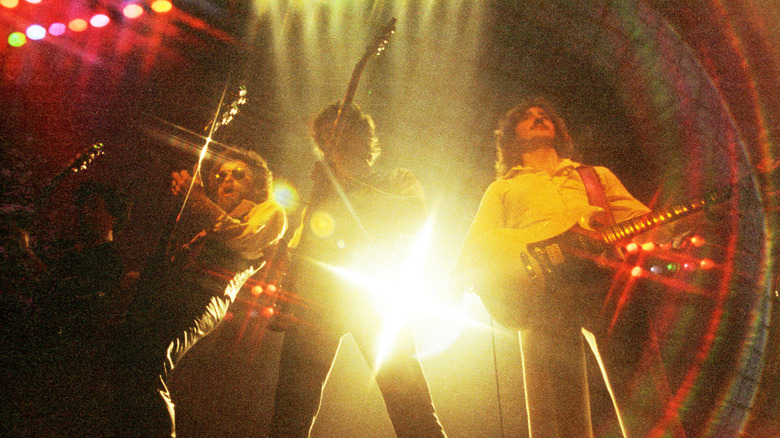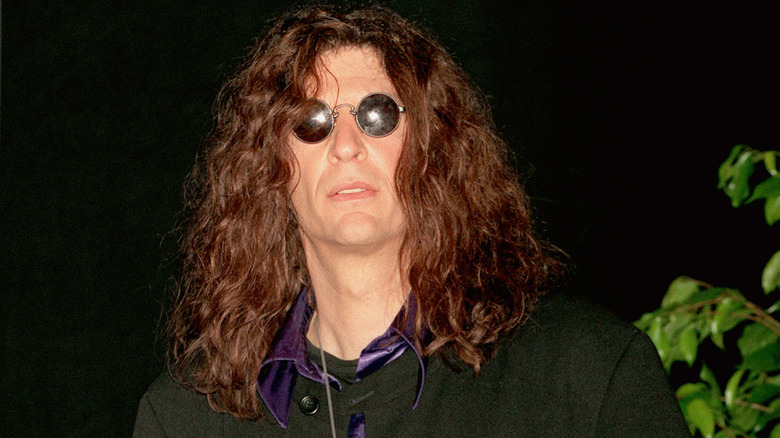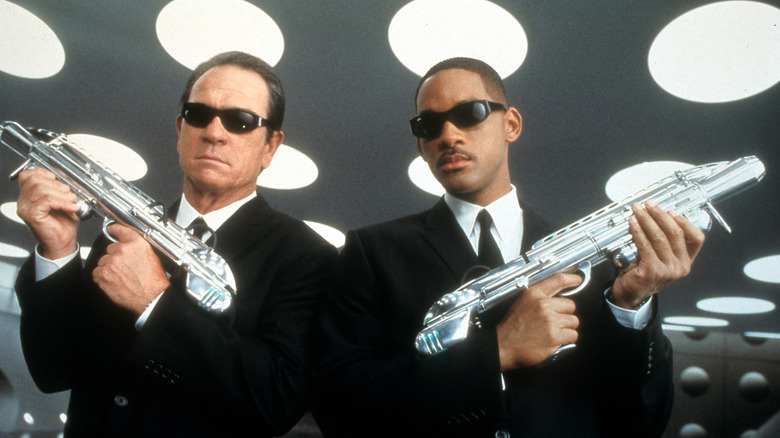The Hidden Truth Of Blue Öyster Cult
When Blue Öyster Cult is discussed in media circles, the word "underrated" tends to be thrown around. That's fair, given that the band is often considered a mid-level band, despite selling in excess of 25 million records over a career spanning five decades and counting. Among those songs, BÖC can claim its fair share of hits, including "Burnin' for You," "Godzilla," and one bona fide classic, "(Don't Fear) The Reaper" (a song that was immortalized on "Saturday Night Live" thanks to Christopher Walken's urgent pleas for "more cowbell!").
The band's history stretches back to the late 1960s in upstate New York, when college pals Albert Bouchard and Donald Roeser (who would adopt the stage name Buck Dharma) began jamming and decided to form a band. After various incarnations and assorted personnel, Blue Öyster Cult emerged, releasing its self-titled debut album in 1972. While there's no denying the band's heyday was in the 1970s and early '80s, BÖC has continued to endure; in 2020, the band released its 14th studio album and its first in 19 years, "The Symbol Remains," followed by "Ghost Stories" in 2024. Clearly, this veteran rock outfit remains a going concern.
There's much about the band that even their most devoted fans may not be aware of. Here's a deep dive into the hidden truth of Blue Öyster Cult.
The band had several incarnations before becoming Blue Oyster Cult
When guitarist Donald Roeser and drummer Albert Bouchard first came up with the notion of forming a band while attending Clarkson College in upstate New York, they called themselves The Disciples. Playing college parties and local beer joints, the group began to attract a local following. When they returned to school the following year, the band reunited under a new name: Travesty.
Travesty broke up, and Roeser returned to his native Long Island, while Bouchard joined a band based in Chicago. When that band went nowhere, Bouchard rejoined Roeser to start a new band in the Long Island area. It was during this time that they hooked up with Sandy Pearlman, a music critic who wrote for a magazine called Crawdaddy!, and under Pearlman's guidance, the band was dubbed Soft White Underbelly. Soft White Underbelly was signed by Elektra Records, and recorded an album that went unreleased.
Singer and guitarist Eric Bloom later joined the band, taking over on lead vocals. Bloom led the band away from its psychedelic sound toward a harder-edged direction, with the band then renamed Oaxaca. Another album was recorded for Elektra, at which point the label dropped them. The group then re-emerged as the Stalk-Forrest Group, with Bouchard's little brother, Joe Bouchard, joining on bass. Finally, Pearlman renamed the group Blue Öyster Cult, the name that would stick for the next half-century.
The band's logo takes its origins from ancient Greece
When Blue Öyster Cult released its first album, its cover was designed by artist Bill Gawlik. Taking his cues from the band's manager, Sandy Pearlman, Gawlik's imagery was steeped in eerie occultism; he went on to design the cover of the band's second album, "Tyranny of Mutation." Both album covers featured a weird symbol, appearing to be an amalgamation of a cross and a fishhook. That logo shares a lot of similarities with the symbol the for mythological Greek god Cronos (also known as Kronos), if it were turned upside down. "He came up with the symbol of Kronos/Saturn that identified us immediately," Albert Bouchard recalled in an interview with Record Collector. "Sandy saw that symbol first so he hired Gawlik on the spot. I think he got $500 a piece for the first two records."
After completing the "Tyranny of Mutation" cover, Gawlik vanished, seemingly dropping off the face of the Earth. Nobody in the band ever heard from him again, and have no idea where he went. "He was sort of eccentric to say the least," Pearlman told author Martin Popoff of Gawlik for his book, "Blue Oyster Cult: Secrets Revealed." In that book, Albert Bouchard recalled the manager describing Gawlik as "this crazy architecture student" with a passion for creating futuristic architectural designs on massive scrolls of paper that would unroll for yards.
Blue Oyster Cult broke new ground with their in-concert laser show
Among the many rock bands to introduce laser beams to their live concerts in the 1970s was Blue Öyster Cult, which added a laser show to its 1976 tour promoting the band's "Agents of Fortune" album. While the laser effects dazzled the crowd, the bulky and delicate equipment proved to be not only expensive — adding $100,000 to the tour's budget — but was also a major hassle, requiring its own tractor-trailer and the hiring of specialized staff (including an optical physicist) to operate it. Meanwhile, because the technology was then in its infancy, the lasers didn't always work when and how they were supposed to.
These effects were ambitious, to say the least. Front man Eric Bloom was outfitted with a special prism that was designed to project a swirling laser cone wherever he pointed into the audience, while drummer Albert Bouchard utilized a custom-designed laser rifle that fired exploding containers of mylar confetti into the audience, which reflected the laser light.
According to the band's manager, Sandy Pearlman, fans attending that tour experienced a true spectacle. "The laser system meets all EPA standards and sure beats smoke-belching airplanes when you wanna do some skywriting," he quipped in a vintage news report (via the band's website).
Blue Oyster Cult's in-concert laser displays were deemed dangerous by the FDA
Blue Öyster Cult's laser displays not only garnered media attention, they also captured the attention of the U.S. Food and Drug Administration. According to a 1978 UPI report (via The Daily News), the band's lasers were flagged by the FDA's Bureau of Radiological Health, a government organization charged with enforcing laws governing radiation. "But lasers do produce potentially hazardous light radiation. Like any other light there is a potential burn hazard. It's like holding a magnifying glass to the sunlight," said an FDA spokesman. While there hadn't been any reports of any serious incidents, the spokesperson offered a what-if scenario, a hypothetical situation in which a laser beam could be inadvertently reflected off, say, the surface of a watch face, and into a concertgoer's eye.
As The Washington Post reported, the FDA issued a warning to Blue Öyster Cult, asking that their laser system be redesigned so that audience members wouldn't come into contact with the show's laser beams. The band agreed to make those changes, likely because there was no other choice. "They've talked to people here and they've worked things out," an FDA spokesman told the Post. "Most of the groups get pretty cooperative when they find we might shut down one of their concerts."
The band's biggest hit was adopted by Stephen King in his masterpiece The Stand
Of all the band's songs, the Blue Öyster Cult track with the most cultural significance has been "(Don't Fear) The Reaper." Not only is it the group's highest-charting hit (making it to No. 12 on the Billboard Hot 100), the 1976 hit was adopted by Stephen King in his epic post-apocalyptic novel "The Stand," with the master of horror excerpting some lyrics from the track. Fittingly, "(Don't Fear) The Reaper" was used in the opening scene of the 1994 TV miniseries adaptation of "The Stand," and again in the 2020 miniseries.
The song has also made it into various other films and TV series, including John Carpenter's 1978 horror classic "Halloween." "I thought the song was unbelievable," the director told The New York Times. "The thing is cinematic all the way."
After its use in the now-classic "Saturday Night Live" cowbell sketch, the song enjoyed a second life in comedies. "It had been used as a go-to creepy thing, but Will Ferrell pretty much sabotaged that," Buck Dharma told the Times, while also observing he'd noticed a swing back to the song's use in darker fare, such as accompanying a grim scene in "Gone Girl." "It has survived the cowbell and retains its original vibe," he said of the song. Referencing the real meaning behind "(Don't Fear) The Reaper," Dharma added, "I want it played at my funeral when I go."
One of the band's founding members is distantly related to Howard Stern
While there are many stars who can't stand Howard Stern, Blue Öyster Cult lead singer Eric Bloom is not among them. That's because he and Stern are actually related. Stern referred to Bloom as his "cousin" when Bloom and Buck Dharma made an appearance on "The Howard Stern Show." "We have strange relationship," Stern told his listeners. "He's really not even my cousin," Stern clarified, explaining that Bloom entered his family by marrying Stern's distant cousin — whom Stern claimed to have never even met.
Interestingly, Stern has another connection to BÖC. His familiar baritone can be heard in a spoken-word intro at the start of the track "When the War Comes," from the band's 1985 "Club Ninja" album. Interviewed by Jeb Wright, bassist Joe Bouchard explained on his website how Stern wound up lending his voice to the song. "I loved listening to Howard Stern in the morning. He was very entertaining," Bouchard said.
Recalling that Bloom's wife was related, Bouchard asked manager Sandy Pearlman to call him up and see if he'd record something. The timing was ideal, given that Stern was out of a job, having just been fired from WNBC. "I just thought it would be great if he could do what he did on the radio," said Bouchard. "He had just been fired so he might have some fire and brimstone in his voice and he did. He brought it to the table."
An American Idol judge wound up on Blue Oyster Club tracks
Howard Stern isn't the only unexpected figure to appear on one of Blue Öyster Cult's songs. Another celebrity featured on a BÖC track is Randy Jackson, who spent more than a decade behind the judging table at "American Idol," a show that has often been accused of being fake. As it happened, Jackson played bass on the dance-friendly track "Shooting Shark," off the band's 1983 album "The Revölution by Night."
At the time he played on that song, reality TV was still years away for Jackson. Then, he was serving as bass player for Journey, a rock band that's endured some truly tragic moments. On his website, BÖC bassist Joe Bouchard told interviewer Jeb Wright about the circumstances that led to Jackson playing bass on the song instead of him. According to Bouchard, Buck Dharma wanted to feature some slap bass on the song, a technique at which Bouchard wasn't even close to adept. "So Randy Jackson came in and slapped the hell out of the bass," Bouchard said. "Yes, the same guy who played with Journey and was on American Idol. He is the nicest guy in the world and a fantastic bass player."
According to Bouchard, Jackson generously spent a few hours teaching him how to slap, so that he'd be able to replicate the bass line when playing the song in concert. "He showed me all the tricks and taught me exercises for being able to do that stuff," Bouchard revealed.
Punk poet Patti Smith wrote several songs for the band, and nearly became lead singer
Among the stranger bits of lore surrounding Blue Öyster Cult is the presence of singer-songwriter Patti Smith on several of the band's albums. Smith, who emerged as a punk poet in the mid-1970s, known for such hard-rocking tracks as "Gloria," "Redondo Beach," and "Dancing Barefoot," also wrote several songs for BÖC. The songs to which she contributed appeared on some of the band's seminal albums, including "Tyranny and Mutation," "Secret Treaties," and "Agents of Fortune."
So how did Smith wind up working with Blue Öyster Cult? As it happened, she was dating BÖC keyboard player Allen Lanier during the early 1970s, and collaborated with him musically. Among the songs on which Smith is credited as writer are "Career of Evil," "Debbie Denise," and the aforementioned "Shooting Shark," which Buck Dharma resurrected years later, based on one of Smith's vintage poems from her earlier days working with the band.
Lanier encouraged Smith to strike out on her own, which led to the formation of The Patti Smith Group and, eventually, her own stardom as a solo artist. As Smith wrote in her 2010 memoir, "Just Kids," being on the road with her band while Lanier toured with BÖC was not an ideal situation for stability, and proved to be the downfall of their romance. "Ultimately it destroyed our relationship," she wrote, "but not the respect I had for him." Lanier died in 2013.
Founding member Albert Bouchard was fired after 14 years behind the drums
Drummer Albert Bouchard was right there at the very beginning of Blue Öyster Cult, his presence predating the band when he and Buck Dharma first began playing together as college students. He remained behind the drums for more than a decade, performing on what became the band's most popular songs — even donning a Godzilla mask while playing the extended drum solo in "Godzilla."
Yet it all came crashing down during the tour in support of the band's 1981 "Fire of Unknown Origin" album, when his bad behavior got the better of him. When he showed up late to two consecutive shows, forcing the band's lighting director to fill in for him on drums, the other members of the band decided to fire him. "Well, I think I was having some personal issues. I was separated from my wife and I had a girlfriend, and I wanted to bring her on tour," Bouchard explained during an interview with Rock History Music. "And they were like, 'No, we think it's a bad idea, you're acting crazy.'"
In hindsight, Bouchard also came to realize that what he felt to be perfectionism came across to his bandmates as browbeating. "I don't know how to say this without sounding egotistical, but I didn't really understand how much I was bullying the rest of the guys ..." he added.
Blue Oyster Cult introduced 'Men in Black' to pop culture
Descriptions of mysterious "men in black" accompanying UFO sightings have been part of conspiracy lore for years, entering the mainstream thanks to such TV shows as "The X-Files," and, of course, the "Men in Black" movies starring Tommy Lee Jones and Will Smith (the latter one of many actors who ruined their careers on live TV). Yet there's an argument to be made that the introduction of the term into mainstream entertainment didn't come from TV or movies, but from Blue Öyster Cult.
That mention dates all the way back to 1976, with the track 'E.T.I. (Extra Terrestrial Intelligence)" featuring the lyrics, "Three men in black said, 'Don't report this.'" A few years later, the MIB were referenced again in the 1983 song "Take Me Away," featuring a lyric stating, "The men in black, their lips are sealed." While it may be debatable how influential those particular songs were in spreading the mythology of the men in black within popular culture, there can be no argument that Blue Öyster Cult came in on the ground floor.
Founding members Buck Dharma and Eric Bloom used AI to complete 2024 album 'Ghost Stories'
In 2024, Blue Öyster Cult unveiled the band's 15th studio album, "Ghost Stories." To call the album new wouldn't be entirely accurate, though; all the album's songs came from an extraordinarily creative period in the late 1970s and early '80s. None of those tracks made it onto any of their albums, and the recordings were long forgotten — until Buck Dharma and Eric Bloom discovered the resurfaced tapes and were blown away by what they heard.
"And it was a big surprise that 'Ghost Stories' sounds like a lost BÖC record from the day," Dharma marveled in an interview with Gold Mine, explaining that the only reason those songs didn't make it onto albums of that era was because each side of a vinyl album could only contain so many songs. Had CDs been around at that time, Dharma said, he was confident those songs would have been included on albums.
He and Bloom decided to release those old tunes, featuring the original BÖC lineup, as a new album, but there was one key problem: the quality of the old, deteriorated tapes was not great. As a result, they turned to technology, utilizing artificial intelligence to clean up the sound. "Where the multitrack tapes existed, we used the multitracks, and where they didn't, we used the stereo mixdowns, and then deconstructed those with the AI technology of today," he added.
